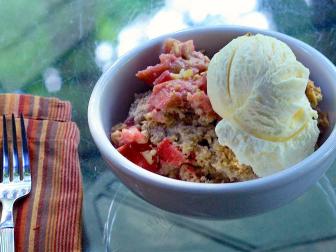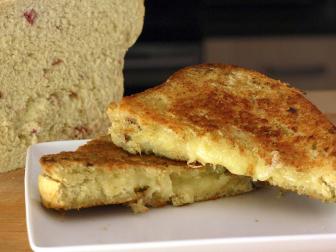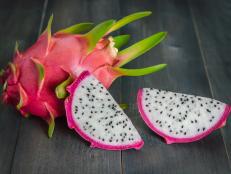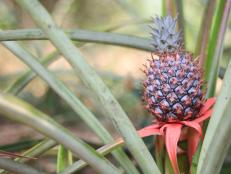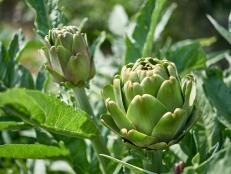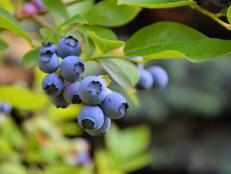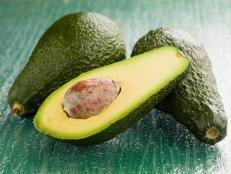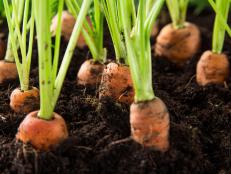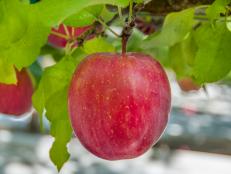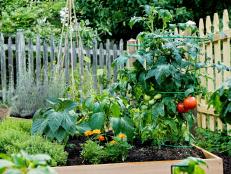How to Grow Rhubarb
Learn how to plant rhubarb and when to harvest rhubarb stalks that can add a distinctive tartness to such treats as pies and jams.
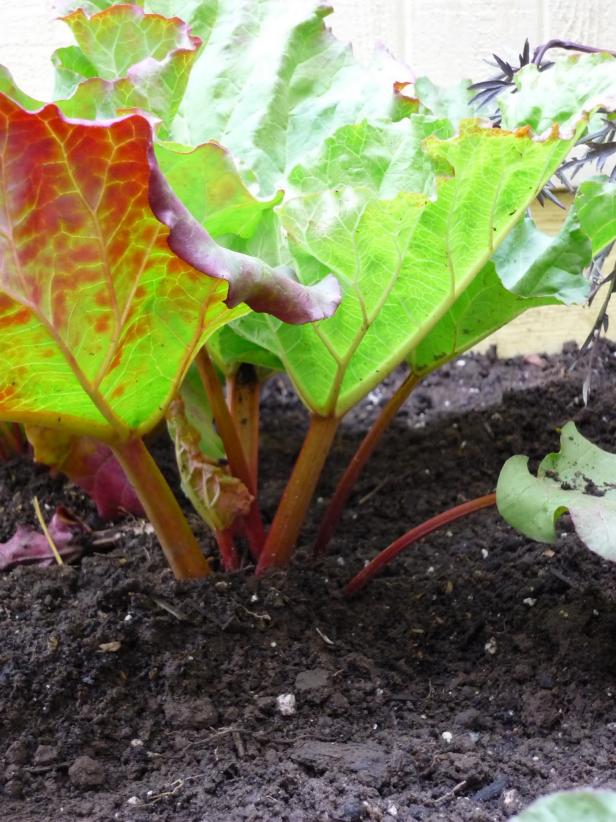
Image courtesy of Amy Stewart

As one of the first crops to come in, the tender and flavorful red, pink or green rhubarb stalks are a welcome sight in the spring. Rhubarb stems add a tart bite to pies, crumbles, cakes, jams and other tasty treats (usually married with sweet fruits like strawberries along with lots of sugar).
With its bold foliage and colorful stems, rhubarb is a carefree and generous perennial crop for much of the country, which has earned it a place of pride in many vegetable gardens and ornamental borders.
The Anatomy of a Rhubarb Plant
Rheum x hybridum, commonly called rhubarb or "pie plant," is a perennial crop that dies back in the fall and puts on new growth each spring. Although rhubarb is usually grown for its culinary value, its large 3-to-4-foot foliage, colorful stems and sometimes bright leaf venation also make this plant an eye-catching ornamental.
While rhubarb is often combined with fruits in sweet dishes, the part of the plant we eat is technically a petiole, or leafstalk. Most gardeners simply call these rhubarb stems or stalks. Rhubarb stems are safe to eat, but leaves and other parts of the plant can be toxic and should not be eaten.
Rhubarb stems originate from the crown, which is the point of new growth at the base of the plant. Mature plants expand slowly by spreading out large rhizomes, or underground stems, that send down new roots and produce new buds. Rhizomes can be split into sections that each contain a root and a few buds and grown as a new plant. These divisions are sold as rhubarb crowns.
Choosing Which Rhubarb to Grow
Seeds or Crowns?
While you can grow rhubarb from seed, gardeners usually start from crowns or divisions from established plants. Mature rhubarb plants need to be divided every three to six years, and many gardeners are happy to share divisions with friends and neighbors. Although it's tempting to pick stems from new plants, rhubarb should not be harvested at all during the first year.
Growing rhubarb from seed costs less than buying new plants. However, varieties may not come up “true to type” (that is, they may not look exactly like the description on the seed packet), and they will need an extra season to grow before harvesting.
Southern gardeners who need to treat rhubarb as an annual crop should start plants from crowns or nursery-grown plants rather than seed. Try to order crowns in the spring that have already been through their winter dormancy. If that isn't possible, order crowns in late summer or fall and keep in cold storage for six weeks before planting out.
Popular Rhubarb Varieties
For the most part, rhubarb varieties are grouped together by stem color. While many selections of rhubarb have been developed (especially in Europe), most of these aren't available to consumers in North America. Here are some of the most delicious and easy-to-find varieties:
- 'Crimson' is named after its bright, cherry red stalks. Most commonly grown in the Pacific Northwest, this variety may be sold under the names 'Crimson Cherry,' 'Crimson Red' and 'Crimson Wine'.
- 'Riverside Giant' is a cold-tolerant selection that produces large, green stems.
- 'Valentine' is a vigorous selection that produces long, thick red stems that keep their color after cooking. This variety is less likely to flower.
- 'Victoria' is one of the most popular varieties on the market. This highly productive selection produces juicy, sweet stems that are either pink or green with pink speckles. This variety is prone to bolt, so plan to remove flowers as they develop.
Getting the Growing Site Ready
Rhubarb can be difficult to grow in southern climates (USDA hardiness zones 7 and above) for two key reasons. First, rhubarb needs to be exposed to temperatures below 40 degrees for about 20 days during the winter in order to properly form new buds for the next growing season. Areas with mild winter weather may have to replant rhubarb annually. Second, rhubarb languishes in extreme summer heat. Rhubarb plants may go dormant or even die in areas of the South where temperatures are consistently above 90 degrees. This means that choosing where to plant rhubarb can be an important decision.
Where to Plant Rhubarb
Rhubarb needs at least six hours of direct sunlight each day to flourish. Gardeners in northern climates that have mild summers should site rhubarb on a warm, sunny south-facing slope. Southern gardeners will have more success growing rhubarb on a cooler north-facing slope or a spot with afternoon shade. For best results and healthy, disease-free plants, choose a spot that has well-drained soil. Rhubarb grown on soggy sites or in heavy clay soils is more susceptible to serious health issues.
Grow rhubarb with your other perennial crops, including strawberries, asparagus or sunchokes. Traditional annual vegetable beds usually experience heavy soil disturbance during planning, weeding, harvesting and removing spent crops, all of which can damage rhubarb roots. If you have to grow rhubarb with annuals, be especially careful to protect the roots while working with your other crops. Remember, rhubarb can reach 3 or 4 feet tall, so give plants plenty of room to grow!
If you are new to growing rhubarb, if you've struggled to grow rhubarb in the past or if you live in an area where rhubarb is especially difficult to grow, try planting rhubarb in a container. Growing rhubarb in a pot gives you more control over the soil quality. Plus, if your rhubarb isn't thriving where you first place the pot, you have the freedom to move the plant to another area of the garden.
Add Organic Matter
Rhubarb thrives in rich, healthy soils. It's a good idea to mix a generous amount of finished compost or fully composted manure in the soil before planting. Use a shovel to incorporate organic matter up to 2 feet into the soil to improve the water-holding capacity and soil drainage and to feed beneficial soil-dwelling organisms.
How to Plant Rhubarb
Starting Rhubarb from Seed
Start rhubarb seed indoors at least six weeks before the last frost. Soak seeds in water for two hours before planting to speed up germination. Fill a pot with a standard soilless potting mixture, then scatter the seeds on the soil surface. Lightly cover with more growing mix, and water gently. Keep the potting mix moist to prevent seedlings from drying out. It may take three weeks for rhubarb to germinate.
It's important to acclimate seedlings to outdoor conditions one week before planting outside. Set plants in a sheltered spot outdoors during the day and bring the seedlings back inside in the evening. Strong and healthy rhubarb seedlings can be planted outdoors after the danger of frost is past.
Starting Rhubarb from Crowns
Plant rhubarb crowns 1 inch deep or shallower with the buds pointed up and the roots facing down. Crowns that are planted too deeply are much more susceptible to crown rot and other serious health issues. Remember, rhubarb gets 3 to 4 feet tall, so allow at least 3 feet of space between plants.
Growing Rhubarb
Water Needs
Best practices for watering rhubarb depend on the climate in your region. Northern gardeners may only need to water rhubarb during drought conditions. Southern gardeners may need to water an inch a week throughout the summer. Folks who garden in more moderate climates may only need to spot water when leaves begin to wilt.
Regardless of how often the rhubarb in your garden needs to be watered, there are some irrigation best practices for healthy plants.
- First, and most importantly, avoid watering the leaves, stems and crown of the plant. Watering rhubarb plants directly can lead to crown rot, a serious plant disease. Instead, water the soil around the plant.
- To water deeply, allow the water to sink in to the soil rather than run off the soil surface. Soaker hoses and drip lines are great ways to water rhubarb without damaging the plant so long as they're placed about 18 inches away from the crown of the plant.
- Avoid overwatering, as this can also lead to crown rot. Try to let the top 2 inches of soil dry out before watering again. Fine textured clay and silt soils won't need to be watered as often as free-draining sandy soils.
- Lastly, wilting leaves are usually a good indicator that your rhubarb plant needs water. If you spot a plant that is flagging, give it a good, deep drink.
Spread Mulch
Mulch is a great way to limit competition from weeds, conserve water, moderate soil temperatures and nourish plants. Spread a thick layer of leaf mold, compost or well-rotted manure on the soil around the base of rhubarb plants. Be careful not to cover the crowns as this can promote serious diseases like crown rot. Apply mulch in the spring and after a hard freeze in the fall. Southern gardeners should use a light-colored organic mulch like straw over the winter to keep the soil cool by reflecting sunlight.
Snip Flower Stalks
Occasionally, rhubarb may try to “bolt” or flower. While flowering is a natural part of any plant's life cycle, producing flowers and setting seeds requires energy that gardeners would prefer go into stem development for the season's harvest or root development for next year's growth. Simply snip off rhubarb flower stalks as they arise and keep an eye out for more blooms in the future.
Rhubarb is more prone to bolt when stressed out from extreme heat or drought. Seed-grown rhubarb and the varieties 'Victoria' and 'MacDonald' are more likely to flower than other selections. Also, more mature plants that are in need of division are more likely to bloom.
Scout for Health Issues
While rhubarb usually isn't troubled by insect pests, it is highly susceptible to a few fungi and oomycetes responsible for crown rot disease, including Phytophthora, Pythium, Rhizoctonia and Botrytis. Crown rot is especially common on plants that have gone dormant during extreme summer heat and rhubarb grown in poorly drained soils. Diseased plants should be removed immediately and any new rhubarb plants should be grown in a different area. If you suspect your rhubarb has a health problem, the experts with your local extension service can offer tailored advice for growing rhubarb in your region.
When to Harvest Rhubarb
While mature rhubarb plants generously produce tender stems throughout the spring, gardeners must be patient with new plants. Transplants and crowns should not be harvested at all in the first season and plants grown from seedlings should not be harvested until the third season.
Rhubarb is ready to pick when the young, crinkly leaves have fully opened and smoothed out. Mature stems should be about an inch wide. Any smaller stalks should be left on the plant so their leaves can photosynthesize and make energy for next year's crop.
How to Harvest Rhubarb
To harvest, firmly grasp the base of the stem with your hand, twist, then pull up. Don't use pruners or a sharp knife as this can spread disease and expose larger wounds that are also open to disease. For best results and healthy plants, only pick up to two-thirds of the developed stems at a time.
Remove the foliage from the stem as soon as possible after harvesting rhubarb. The large leaves can continue to pull water from the cut stem, causing the stem to soften and wilt. Trim and toss leaves in the compost heap. Rhubarb foliage contains high levels of oxalic acid and anthraquinone glycosides, which means the leaves can be toxic and should not be eaten.
Depending on your climate and the age and health of your plants, rhubarb can be harvested between three and five times each year. You can harvest sparingly later in the season, but the stems will be stringy, tough and less palatable than the tender spring stems.
A mature and healthy plant can produce between 2 and 6 pounds of stems in a year. If your harvest exceeds your appetite, simply chop up and freeze your extra rhubarb to use later in the season.
How to Force Rhubarb
Forcing rhubarb is a great way to get an early crop of especially tender and flavorful stems. The simplest way to force rhubarb is to cover plants with a bucket, trash can or special terra cotta forcing jar. New growth that is deprived of light will be sweeter, more tender and lighter in color.
Indoor forcing is a little more involved but will result in an even earlier crop. Lift plants after a hard freeze when weather is reliably cold. (November may be a good time in many parts of the country.) To break dormancy, simply leave the crowns out to chill on the surface of the soil for two weeks. After the chill period, pot up crowns and move to a cool, protected environment like a garage, basement or greenhouse where the temperatures hover around 45 to 60 degrees. Keep plants covered with a bucket, trash can or forcing jar. Forced rhubarb should be ready to harvest in about five weeks.
For best results, choose plants that are two years or older for early forcing. Avoid forcing the same plant in consecutive years to keep plants healthy and productive.
How to Divide Rhubarb
Many perennial plants need to be divided regularly to stay vigorous and productive, and rhubarb is no exception. If left undivided, older plants will become congested, with smaller stems and an empty spot in the center of the plant. The new divisions can be used to expand your rhubarb planting, replace unproductive plants, or share with friends and neighbors. Plan to divide mature plants every three to six years.
To divide rhubarb, simply lift the plant with a shovel or pitchfork. Use a clean, sharp spade or planting knife to cut the plant into two or more smaller sections. Each division should have a section of root and between one and three buds. When transplanting rhubarb, prepare the garden bed before replanting (see “Getting the Site Ready”).
Rhubarb is a heavy feeder that can deplete the soil. If space allows, try moving rhubarb to a new area of the garden each time you divide and replant with cover crops or legumes that will improve the soil quality.
Rhubarb Recipes
Rhubarb Crisp: The Tart of Baking
Tangy and sweet flavors meld into one delicious whole with this rhubarb recipe.
Rhubarb Bread Recipe
This venerable veg is not just for pie anymore.






